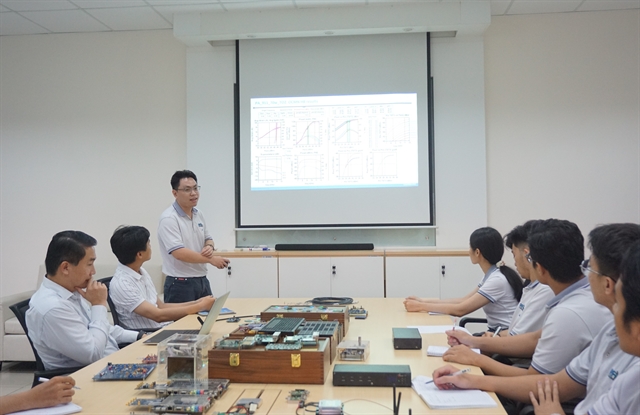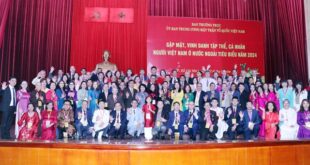 |
| A meeting to discuss research topics at the HCM City University of Technology’s lab for microchip and high-frequency systems. — VNA/VNS Photo Thu Hoài |
HCM CITY — Seeing strong demand for human resources in the semiconductor integrated circuit (IC) technology industry in Việt Nam, Việt Nam National University-HCM City (VNU-HCM) targets to train about 1,500 engineers and 500 master’s degree students in IC design by 2030.
VNU-HCM chancellor Vũ Hải Quân said the university had set a goal of providing in-depth training in IC design to meet the need for high-quality human resources for the development of the semiconductor IC technology industry in the country and the world.
“This target helps affirm VNU-HCM’s position domestically and internationally, contributing to the implementation of the university’s goal to be among the leading higher education institutions in Asia,” he said.
Accordingly, its member universities will train and grant industrial and international certifications in IC design to around 15,000 engineers over the next seven years.
Prime Minister Phạm Minh Chính has recently emphasised the need to increase investment in the development of human resources for the research of semiconductor IC technology in Việt Nam.
Many local universities have begun enrolling and training students in IC design and IC Technology majors to meet labour market demand in this field.
However, training human resources in this field requires the schools to have good facilities, modern laboratories, training programmes, experienced teaching staff, and cooperation networks.
Among member universities of VNU-HCM, the HCM City University of Technology has been a pioneer in training the semiconductor IC design industry for over 20 years, providing about 300 students with expertise related to IC design to the labour market each year.
So far, more than 6,000 students have graduated in this field from the university.
 |
| A HCM City University of Technology’s lecturer instructs his students doing research at the lab for microchip and high-frequency systems. — VNA/VNS Photo Thu Hoài |
The HCM City University of Technology Principal Mai Thanh Phong said the semiconductor IC supply chain was divided into four stages: design, production, packaging and testing, and equipment manufacturing.
“Việt Nam has many advantages to participate deeply in IC design for the global semiconductor IC supply chain, which accounts for 53 per cent of the added value of a product,” he said.
Many big IC companies, such as Samsung, LG, Sharp and Foxconn, were reported to be planning to expand in Việt Nam, creating a demand for high-quality semiconductor IC human resources and huge opportunities for the country.
Therefore, Việt Nam needed stronger human resources to serve the growing IC demand and create greater investment opportunities.
To meet this urgent demand, the HCM City University of Technology stayed ahead of the world’s science and technology development trends, Phong said.
The university’s vision is to become an excellent scientific research and training centre that plays a pioneering role in leading the domestic semiconductor IC field, according to Phong.
Its training programmes in IC are developed and taught by a team of 200 lecturers from the Department of Electrical and Electronics Engineering, Department of Computer Science and Engineering, and Department of Materials Technology.
All lecturers graduated with PhD degrees from countries with advanced semiconductor IC industries such as the US, Germany, France, Australia, Japan and the Republic of Korea.
In the upcoming 2024-25 academic year, the university will officially begin two new majors, IC design and Semiconductor IC.
Graduates from the university with bachelor’s degrees in IC Design will be able to find a job at most IC design companies both locally and abroad.
The Semiconductor IC major at the post-graduate level will provide advanced knowledge and skills in designing and manufacturing ICs.
“The majors are expected to supply high-quality human resources for the semiconductor IC industry,” Phong added.
Solutions
Huỳnh Phú Minh Cường, deputy head of the Faculty of Electrical and Electronics Engineering at the HCM City University of Technology, said training high-quality IC design engineers required modern laboratories, good training programmes, experienced lecturers, and collaboration between domestic and international training institutions.
 |
| A student conducting research at the HCM City University of Technology’s lab for microchip and high-frequency systems. — VNA/VNS Photo Thu Hoài |
Since 2013, the university set up a lab for microchip and high-frequency systems which specialises in the design and testing of semiconductor ICs, with modern equipment and a research team of about 40 people.
The research team of the lab successfully designed the three microchips of CMOS RF DVB-T2 TUNER, attached with the university logo, which had been manufactured in Taiwan (China).
“Everyone is working hard to show the skills of the university’s professional team and the effectiveness of the training programmes here,” he said.
The HCM City University of Technology has established cooperation relationships in training and scientific research in the field of semiconductor IC with many famous universities in the world such as the University of Illinois Urbana-Champaign and Texas A&M University in the US, and KAIST in the Republic of Korea.
The school has also cooperated with large organisations and businesses such as Marvell Technology and Synopsys, and received copyright sponsorship of specialised software systems from Synopsys and Cadence – the world’s two largest companies providing IC design tools.
To achieve the goal of in-depth training in IC design, Vũ Hải Quân said it would be necessary to invest in a system of laboratories in both the north and south of the country for common use by universities in research and training in IC design.
“Through these laboratories, Việt Nam can develop a number of innovative startups in the field of semiconductor IC technology,” he said.
He proposed that the Government soon issue a strategy for developing the semiconductor technology industry, including investment resources for training and research.
He also recommended policies on promoting links and cooperation between universities and businesses; international cooperation; and cooperation with universities around the world to expand and develop advanced training programmes on IC design. — VNS
- Reduce Hair Loss with PURA D’OR Gold Label Shampoo
- Castor Oil Has Made a “Huge” Difference With Hair and Brow Growth
- Excessive hair loss in men: Signs of illness that cannot be subjective
- Dịch Vụ SEO Website ở Los Angeles, CA: đưa trang web doanh nghiệp bạn lên top Google
- Nails Salon Sierra Madre
 VnExpress News The News Gateway of Vietnam
VnExpress News The News Gateway of Vietnam





